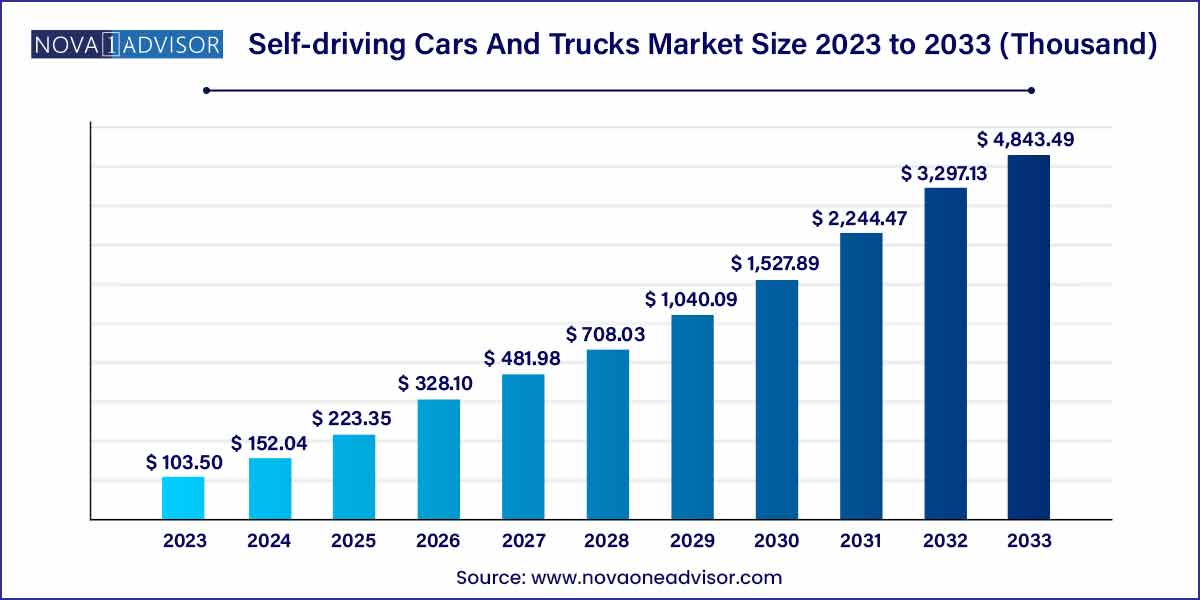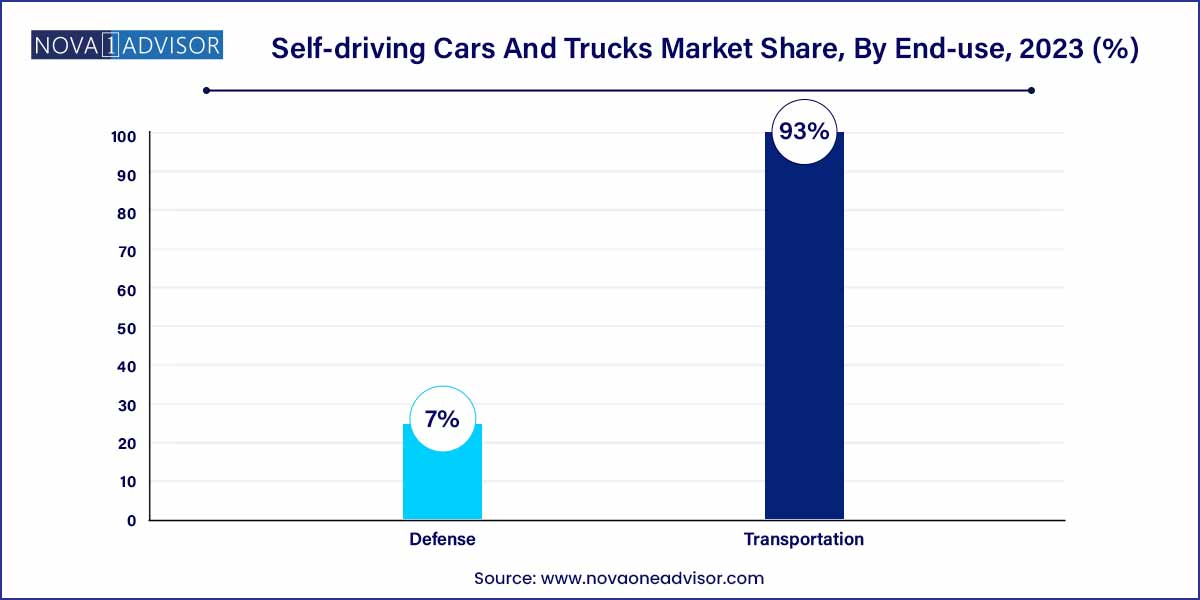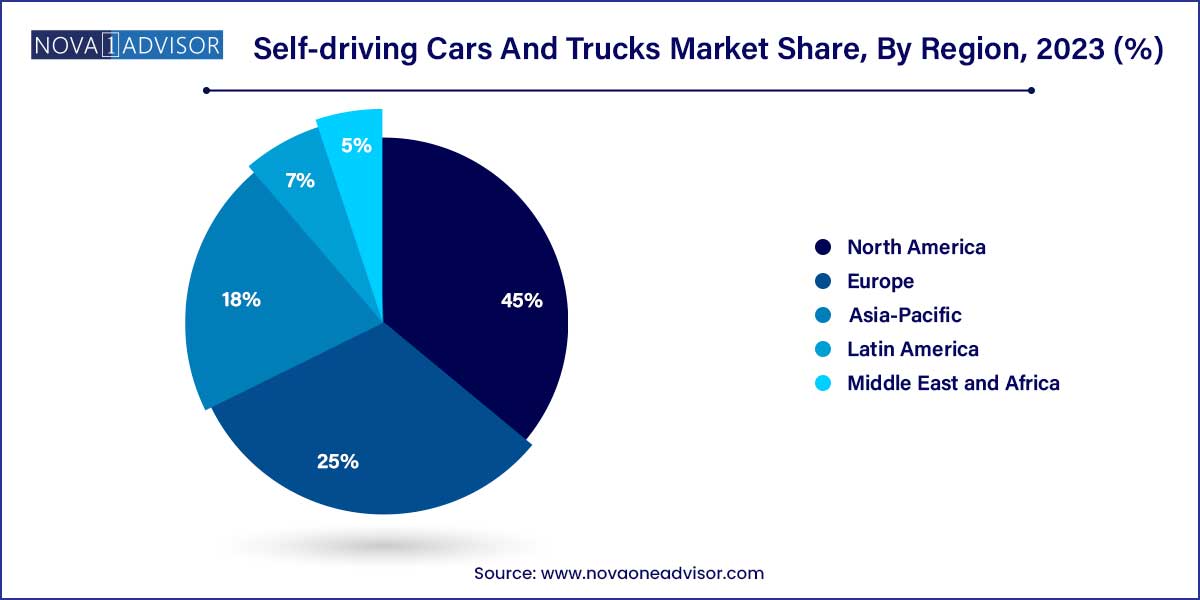The global self-driving cars and trucks market size was exhibited at USD 103.50 thousand in 2023 and is projected to hit around USD 4,843.49 thousand by 2033, growing at a CAGR of 46.9% during the forecast period of 2024 to 2033.

Key Takeaways:
- The North American region led the market with a volume share of 45.0% in 2023.
- The transportation segment dominates the market with a volume share of more than 93.0% in 2023.
Market Overview
The self-driving cars and trucks market represents a transformative frontier in the automotive and logistics industries. Encompassing fully autonomous and semi-autonomous vehicles, this market includes technologies, platforms, and vehicle applications that operate with minimal or no human intervention. Autonomous vehicles (AVs) promise to revolutionize how people and goods move by enhancing safety, reducing operational costs, improving efficiency, and enabling entirely new business models in urban mobility, freight, and defense sectors.
With advancements in artificial intelligence (AI), machine learning, LiDAR, radar, GPS, and edge computing, autonomous systems are evolving from conceptual prototypes to viable commercial solutions. As of 2025, several companies are conducting pilot programs and limited commercial deployments in both passenger transportation and freight logistics. While regulatory and technical challenges remain, the industry’s momentum is undeniable. In urban environments, self-driving taxis are beginning to reshape ride-hailing; in logistics, autonomous trucks are transforming long-haul transport with 24/7 operational capabilities; and in defense, unmanned ground vehicles (UGVs) are improving battlefield logistics and surveillance.
The market is supported by investments from automotive OEMs, tech giants, venture capital firms, and public-private partnerships. Regulatory bodies in various countries are beginning to adopt frameworks for testing and commercializing AVs, thereby reducing barriers to entry. As a result, the self-driving cars and trucks market is rapidly transitioning from a research-intensive field to a commercialized, multi-billion-dollar industry with far-reaching implications for public safety, environmental sustainability, and economic productivity.
Self-driving Cars And Trucks Market Report Scope
| Report Coverage |
Details |
| Market Size in 2024 |
USD 103.50 Thousand |
| Market Size by 2033 |
USD 4,843.49 Thousand |
| Growth Rate From 2024 to 2033 |
CAGR of 46.9% |
| Base Year |
2023 |
| Forecast Period |
2024-2033 |
| Segments Covered |
Application |
| Market Analysis (Terms Used) |
Value (US$ Million/Billion) or (Volume/Units) |
| Regional Scope |
North America; Europe; Asia Pacific; Central and South America; the Middle East and Africa |
| Key Companies Profiled |
Audi AG; BMW AG; Daimler AG; Ford Motor Company; General Motors Company; Google LLC; Honda Motor Co., Ltd.; Nissan Motor Company; Tesla; Toyota Motor Corporation; Uber Technologies, Inc.; Volvo Car Corporation; Volkswagen AG. |
Self-driving Cars And Trucks Market Dynamics
- Technological Innovation and Advancements:
The self-driving cars and trucks market is dynamically shaped by continuous technological innovation. Breakthroughs in Artificial Intelligence (AI), machine learning, and sensor technologies have elevated the capabilities of autonomous vehicles. These advancements not only enhance the vehicles' ability to navigate complex environments but also contribute to improved safety features. The integration of sophisticated computing systems and real-time data processing plays a pivotal role in the evolution of self-driving technology. Companies within the industry strive to stay at the forefront of innovation, fostering a competitive landscape that drives the market forward.
- Regulatory Landscape and Compliance:
The market dynamics of self-driving cars and trucks are significantly influenced by the evolving regulatory landscape. As autonomous vehicles become more prevalent, governments worldwide are establishing frameworks to govern their use. Compliance with these regulations is paramount for industry players, influencing the design, testing, and deployment of self-driving technologies. Navigating these regulatory environments requires a delicate balance between innovation and adherence to safety standards. The regulatory framework not only ensures the responsible development of autonomous vehicles but also shapes the public's perception and acceptance of this transformative technology.
Self-driving Cars And Trucks Market Restraint
- Public Skepticism and Trust Issues:
A significant restraint in the self-driving cars and trucks market is the prevailing skepticism and trust issues among the general public. Despite technological advancements and safety assurances, many individuals remain apprehensive about relying on autonomous vehicles. High-profile incidents and ethical considerations surrounding decision-making algorithms contribute to a lack of trust in the reliability and safety of self-driving technology. Overcoming this skepticism requires not only continued technological refinement but also concerted efforts in public education to increase awareness and build confidence in the capabilities and safety of autonomous vehicles.
- Ethical and Legal Challenges:
The self-driving cars and trucks market faces complex ethical and legal challenges, acting as a significant restraint. Determining responsibility and liability in the event of accidents involving autonomous vehicles remains a pressing concern. The intricacies of decision-making algorithms and the potential for unforeseen circumstances pose challenges in defining a clear legal framework. Additionally, ethical considerations regarding the prioritization of actions in critical situations raise questions about the moral implications of autonomous driving. Addressing these challenges requires collaboration between the automotive industry, legal experts, and policymakers to establish comprehensive guidelines that balance innovation with ethical and legal considerations.
Self-driving Cars And Trucks Market Opportunity
- Enhanced Safety and Accident Reduction:
A prominent opportunity in the self-driving cars and trucks market lies in the potential for significantly enhanced safety and a substantial reduction in accidents. Autonomous vehicles leverage advanced sensor technologies and real-time data processing to perceive their surroundings, make split-second decisions, and execute actions with precision. The integration of self-driving technology has the potential to minimize human errors, a leading cause of accidents, and create a safer driving environment. This opportunity not only addresses public concerns about road safety but also presents a compelling proposition for widespread adoption and acceptance of autonomous vehicles.
- Improved Accessibility and Mobility Solutions:
The self-driving cars and trucks market offers a transformative opportunity to improve accessibility and mobility solutions. Autonomous vehicles have the potential to revolutionize transportation for individuals with mobility challenges, including the elderly and people with disabilities. By providing a reliable and convenient mode of transportation, self-driving cars and trucks can enhance the overall mobility of individuals who may face limitations in conventional transportation options. This opportunity aligns with the broader goal of creating more inclusive and accessible transportation systems, opening up new markets and catering to a diverse range of passengers.
Self-driving Cars And Trucks Market Challenges
- Technical Complexity and Reliability:
A primary challenge in the self-driving cars and trucks market is the inherent technical complexity of developing reliable autonomous systems. The intricate integration of Artificial Intelligence (AI), sensor technologies, and communication systems demands a high level of precision and dependability. Ensuring the reliability of these systems in diverse and unpredictable real-world scenarios, including adverse weather conditions and complex urban environments, remains a formidable challenge. Technical glitches and system failures raise concerns about the safety and effectiveness of self-driving vehicles, necessitating rigorous testing and ongoing refinement of autonomous technologies.
- Regulatory Uncertainty and Legal Frameworks:
The self-driving cars and trucks market faces substantial challenges related to regulatory uncertainty and the establishment of clear legal frameworks. As autonomous vehicles become more prevalent, governments and regulatory bodies are tasked with developing and adapting regulations to address safety, liability, and ethical considerations. The absence of standardized regulations across jurisdictions poses challenges for manufacturers and hinders the seamless deployment of autonomous vehicles. Navigating these regulatory landscapes requires industry collaboration and proactive engagement with policymakers to establish comprehensive and consistent frameworks that ensure the responsible development and deployment of self-driving technology.
Segments Insights:
Application Insights
The commercial transportation segment dominates the self-driving market, especially in long-haul trucking and delivery services. Autonomous trucks are being deployed on fixed routes, often between logistics hubs or on interstates, where consistent lane markings and minimal intersections simplify navigation. Companies such as Aurora, TuSimple, and Kodiak Robotics are partnering with logistics giants like FedEx and UPS to deploy AV trucks in pilot operations across the U.S. These trucks are equipped with redundant safety systems, high-resolution sensors, and adaptive cruise technologies to operate safely with minimal human intervention. The economic incentive is substantial: reduced fuel costs, elimination of driver labor, and round-the-clock operations offer significant ROI for commercial fleets.

The industrial sub-segment is the fastest-growing, primarily in mining, agriculture, and construction sectors. In controlled environments such as mines or large farms, self-driving vehicles can operate without the complex variables of urban traffic, making them ideal candidates for early autonomy. For instance, companies like Caterpillar and Komatsu have deployed autonomous haulage systems (AHS) in mining operations globally. These vehicles reduce labor costs and improve safety in hazardous zones. In agriculture, John Deere has introduced self-driving tractors that use GPS and vision systems to plow, seed, and harvest with precision. This segment is growing rapidly due to measurable ROI and lower regulatory hurdles.
Regional Insights
North America dominates the self-driving vehicle market, driven by strong investment from both the private and public sectors. The United States is home to many of the industry’s frontrunners, including Waymo (Alphabet), Tesla, Cruise (GM), Aurora, and Apple. The regulatory framework, particularly in states like California, Arizona, and Texas, is relatively advanced, supporting AV testing and limited commercial deployment. The U.S. Department of Transportation has also issued guidelines to support AV development while ensuring public safety. Major urban areas are already piloting robotaxi services, and long-haul AV freight routes are being developed across states. Canada is also participating in this transformation, with AV testing hubs in Ontario and Quebec.

Asia-Pacific is the fastest-growing region, fueled by rising urbanization, supportive government initiatives, and significant investments from China, Japan, and South Korea. China’s Baidu Apollo platform leads robotaxi trials in cities like Beijing and Wuhan, while Pony.ai and AutoX have secured permits for fully driverless operations. The Chinese government’s smart city blueprint includes extensive AV integration, backed by 5G deployment and AI development. In Japan, Toyota is investing in autonomous shuttles for its Woven City prototype, and South Korea is supporting AV testing in Seoul through regulatory sandbox programs. With a strong combination of domestic innovation and government backing, Asia-Pacific is poised to lead in AV deployment at scale.
Some of the prominent players in the Self-driving cars and trucks market include:
- Audi AG
- BMW AG
- Daimler AG
- Ford Motor Company
- General Motors Company
- Google LLC
- Honda Motor Co., Ltd.
- Nissan Motor Company
- Tesla
- Toyota Motor Corporation
- Uber Technologies, Inc.
- Volvo Car Corporation
- Volkswagen AG
Segments Covered in the Report
This report forecasts revenue growth at global, regional, and country levels and provides an analysis of the latest industry trends in each of the sub-segments from 2021 to 2033. For this study, Nova one advisor, Inc. has segmented the global self-driving cars and trucks market.
Application
By Region
- North America
- Europe
- Asia-Pacific
- Latin America
- Middle East & Africa (MEA)



